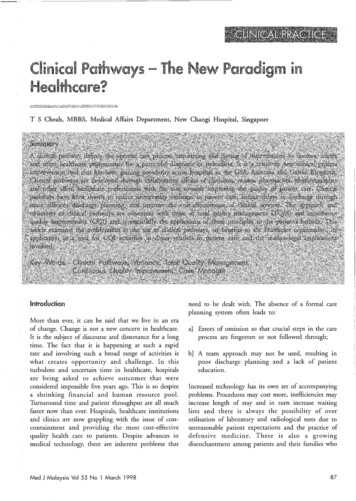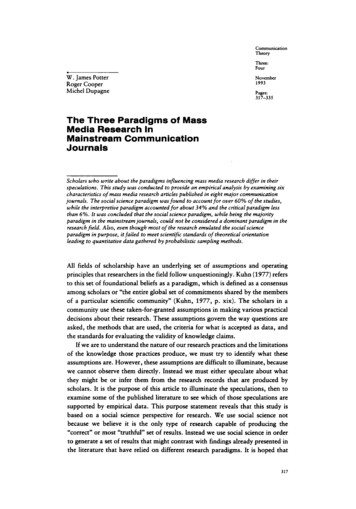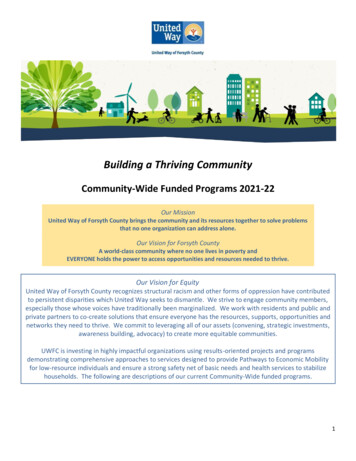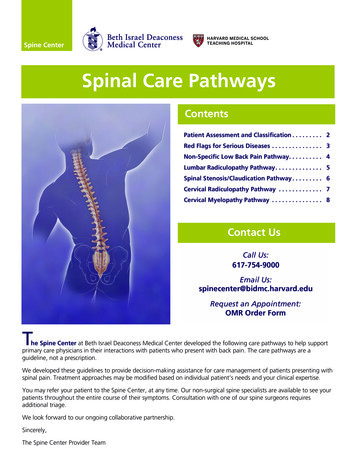
Transcription
CLINICAL PRACTICEClinical Pathways - The New Paradigm inHealthcare?T S Cheah, MBBS, Medical Affairs Department, New Changi Hospital, SingaporeIntroductionMore than ever, it can be said that we live in an eraof change. Change is not a new concern in healthcare.It is the subject of discourse and dissonance for a longtime. The fact that it is happening at such a rapidrate and involving such a broad range of activities iswhat creates opportunity and challenge. In thisturbulent and uncertain time in healthcare, hospitalsare being asked to achieve outcomes that wereconsidered impossible five years ago. This is so despitea shrinking financial and human resource pool.Turnaround time and patient throughput are all muchfaster now than ever. Hospitals, healthcare institutionsand clinics are now grappling with the issue of costcontainment and providing the most cost-effectivequality health care to patients. Despite advances inmedical technology, there are inherent problems thatMed J Malaysia Vol 53 No 1 March 1998need to be dealt' with. The absence of a formal careplanning system often leads to:a] Errors of omission so that crucial steps in the careprocess are forgotten or not followed through;b] A team approach may not be used, resulting inpoor discharge planning and a lack of patienteducation.Increased technology has its own set of accompanyingproblems. Procedures may cost more, inefficiencies mayincrease length of stay and in turn increase waitinglists and there is always the possibility of overutilisation of laboratory and radiological tests due tounreasonable patient expectations and the practice ofdefensive medicine. There is also a growingdisenchantment among patients and their families who87
CLINICAL PRACTICEare unaware of the plan of medical care. Hospital staffhave also expressed unhappiness over unplanneddischarges.The challenge in healthcare today is to engineer theefficient use of shrinking resources while maintainingor even increasing quality outcomes in patient care.Hospitals should foster increased collaboration betweendisciplines to ensure continuity of care both duringthe period of hospitalisation and into the community.Clinical Pathways or critical pathways or care pathsis one such tool that has been developed to addressthese problems. This new innovation in clinical processmanagement and documentation may be the newparadigm for healthcare provision in the 21st Century.Description of a Clinical PathwayA clinical pathway is an optimal sequencing andtiming of interventions by clinicians, nurses and otherhealthcare professionals for a particular diagnosis orprocedure, designed to minimise delays and resourceutilisation and to maximise the quality of care. Criticalpath methodologies originated in the construction andengineering industries where they have been in use formany years in manufacturing and production lines.They have been proven to be of great value inmanaging large complex projects such as aircraftmanufacturing.In healthcare, concepts related to critical paths werefirst discussed and researched in the early 1970s, butthe environment for implementation was not receptive.The reason was that in the USA, at that time,hospitals were reimbursed on a dollar for dollar basisfor their full costs by most payers. Hence, there wasno financial incentive to optimise resource utilisation.In addition, most doctors resisted formal efforts torestrict their freedom to practice as they wished!.Beginning in the early 1980s, however, hospitalreimbursement systems began to feature prospectivepayment and competitive bidding. These changesstimulated renewed interest in critical paths and relatedsubjects such as clinical practice guidelines andalgorithms. Other factors that stimulated renewedinterest included increasing evidence of unacceptablevariation in clinical care and outcomes, a trend towardsincreasing input from multiple professionals in the88decision making process for patient care and increasingmalpractice costs2,3. Since the mid 1980s, healthcarein the USA has seen an escalation in the use of clinicalpathways. There seems to be no stopping this increase,and hospitals and managed healthcare companies arefinding more and more ways of using clinical pathwaysfor their patients and clients. Hospital administratorssee pathways as a means to standardise the length ofstay for defined patient populations, thereby allowingthem to predict the financial outcome of thehospitalisation. Clinicians and nurses see pathways asa means to provide quality of care of a minimumstandard. They also use pathways as an educationaltool. Insurance companies and health maintenanceorganisations (HMOs) see pathways as an ideal toolfor the estimation of hospitalisation costs andreimbursement. Clinical pathways have therefore servedthe needs of a multitude of users, both within thehealthcare system and external third party payers.A clinical pathway is essentially a plan of care thatreflects best clinical practice and the expressed needsof the patient on the pathway. It describes the patternof care for the usual patient. It represents theminimum standard of care and ensures that theessentials are not forgotten and are performed on time.Conventionally, pathways are written in the form of agrid (or matrix) which displays aspects of care on oneaxis and time intervals on another. The time intervalsare typically in the form of a day by day clinical orderand documentation sheet. However, this may vary,depending on the nature and progression of the illnessor procedure being performed. Pathways designed forchronic conditions could have timelines in the formof weeks or months.Clinical pathways integrate medical treatmentprotocols, nursing care plans and the activities of alliedhealthcare professionals into a single care plan, whichclearly defines the expected progress and outcomes ofa patient through the hospital system. Typically,pathways are developed for high-volume, high-risk andhigh-cost diagnoses and procedures. For ease of use,staff actions and interventions in the clinical pathwayare organised into categories. Usually, the followingprocesses are tracked: consults and assessments, tests,treatment and medication, nutrition, activity or safety,patient education and discharge planning4 AdditionalMed J Malaysia Vol 53 No 1 March 1998
CLINICAL PATHWAYScategories of intervention can be included dependingon the nature of the diagnosis or procedure. Inaddition to the types of interventions, a new secondgeneration of clinical pathways called CareMaps developed by the Center for Case Management inBoston, USA and widely used by many hospitals,incorporate expected problems, responses andoutcomes5 . This is in line with the current trend forhospitals and clinicians to track, measure and manageclinical outcomes as a means towards improving thequality of care. The advantage to this approach is thatthe doctor, patient and family know the typicalprogress of a patient along the care provided. Forexample, pain, activity tolerance, knowledge deficit,anxiety, etc can be tracked.The method of documentation on the clinical pathwayis a matter for consideration. When clinical pathwayswere first implemented, the documents were used onlyas guidelines and therefore were not kept as part ofthe medical record. As such, the clinical pathways wereoften discarded after discharge from hospital. In somecases, the pathways were retained for quality assurancepurposes or clinical audits. This severely limited theuse and acceptance of the clinical pathway among thecare givers, especially the ward nurses and doctors.Since the early 1990s, it has become common practiceto include the clinical pathways as part of thepermanent medical record. Documenting directly onthe pathway would reduce the time required forcharting, especially for nurses. The pathway wouldinclude columns for the ward nurses to document thecompletion of relevant interventions every shift.Doctors can now document directly on the clinicalpathway - it replaces the conventional clinician orderssheet. Such an integrated clinical documentation sheethas significant advantages. For instance, all membersof the care team now have easy access to all theimportant information related to the care plan, whichis outlined on the clinical pathway. In this manner,the team works together to achieve the same objectivesand clinical outcomes.Clinical pathways most often are applied to the inpatient hospital setting. However, it can also be equallyeffectively and usefully applied to the outpatientsetting, especially for patients who require multipleoutpatient visits with a defined plan of clinicalMed J Malaysia Vol 53 No 1 March 1998management. In this setting, a clinical pathway couldbe written to reflect the necessary interventions to becompleted for each outpatient clinic visit and thedesired outcomes after each visit. Currently, mostclinical pathways are developed by health careprofessionals, with little or no direct input frompatients. The increasing focus on patients as part ofcontinuous quality improvement may result in amovement towards more patient input in developingpathways, particularly for long term chronic care. Inessence therefore, each clinical pathway defines theproblems that patients in a specified case type typicallyencounter and thus directs the development of acomprehensive approach to their care. When caregiverscollaborate, a picture evolves describing whatinterventions are to be delivered and what results oroutcomes can be anticipated over the course of apredicted length of stay. Well developed clinicalpathways identifY patient problems and associatedclinical interventions needed to avoid adverse effectsof care (for example, wound infection), improvephysiologic outcomes, reduce pathologic signs andsymptoms and improve the patient's functional stateand well being.Currently, most clinical pathways are developed foracute or chronic in-patient care. These clinicalpathways are initiated either at the time of admissionor the commence ent of a procedure and end at thetime of discharge. Clinical pathways have also beendeveloped for a complete episode of care - ie fromthe time the patient presents at the clinician's officeto the end of follow up post-hospitalisation. In thearea of chronic long term care, clinical pathways arebeing developed that span the care continuum ftomthe acute setting to the community hospital and evento the home environment. For such pathways, thetimelines would probably be writren as per visit orper week or even per month, depending on the natureof the progression of the disease.VarianceFlexibility is the key in using clinical pathways. Theyare guidelines and maps, not inflexible dictates for care.Because clinical pathways reflect the care needed bymost, but not all patients within a defined population,situations arise in which there are differences from the89
CLINICAL PRACTICEanticipated plan of care. A well designed clinicalpathway will capture between 60 to 80 percent ofpatients within a defined population. This is becausea clinical pathway can only be designed for the usualpatient. Some patients will fall off the pathway duringthe course of their hospitalisation. Some patients willencounter problems in the course of theirhospitalisation, causing variation in the interventionsand outcomes. Variances are the unexpected events thatoccur during patient care - events that are differentfrom what is predicted on the clinical pathway. Despitethe intent to define the essential components of care,there still is variation in how care will be deliveredand how patients will respond. Variance can be positiveor negative. Positive variance occurs when the patientprogresses towards projected outcomes earlier thanexpected, when preselected interventions such as painmedication administration are unnecessary, or wheninterventions such as patient education can successfullybegin at an earlier stage. Negative variance occurs wheneither the patient fails to meet projected outcomes,there is a delay in meeting the outcomes, or there isan need for additional interventions previouslyunplanned.An essential part of the use of clinical pathways isthe collection and analysis of information obtainedwhen patients deviate from the pathway. Analysis ofvariation provides useful and accurate information onthe frequency and causes of variations in patient care.The analysis encourages members of themultidisciplinary healthcare team to adhere to theguidelines and standards set in the pathway, or justifYthe reasons for variations. In this way, clinical pathwayscompel doctors and healthcare providers to criticallyevaluate and understand about the basis of clinicaldecisions. Several authors have shown that usingclinical pathways and clinical practice guidelines canimprove clinical outcomes and the quality of patientcare by reducing avoidable variation in the clinicalprocess 6,7,B. Analysis of variance is also a powerfulclinical audit tool as all aspects of patient care areconstantly reviewed and revised. Improvements in thequality of care are achieved through continuouslyredefining the pathways to reflect current best practice.This is the essence of continuous quality improvementincorporated into clinical practice. Variance data areused most effectively as a means of educating clinicians90and enabling them to make considered changes to theirpractice based on emerging trends and the results ofthat care. The clinicians and the clinical pathwaysdevelopment team are intimately involved as theydetermine whether the variance data indicate thatchanges are needed in the clinical pathway itself orwhether other system changes are required.Case ManagersCase managers are trained clinical nurse specialists ormedical social workers who coordinate the care forspecified patients through the entire episode of il!ness.Case managers are a new breed of health careprofessionals who are responsible for the ongoingcoordination, monitoring, and evaluation of thepatient's progress along the clinical pathway orthroughout the episode of illness. In most hospitalsand institutions, case managers are the crucial staff whodrive the clinical pathway programme. They are thesoldiers who execute the necessary actions required todevelop and implement the clinical pathways. Typically,variances at the ward level would be collected anddocumented by the staff nurse. The case managerswould abstract the important variance data and analysethem. Monthly or quarterly reports on variances andthe outcome of patients on the various clinicalpathways are presented to the hospital specialists andmanagement for further follow up actions.Case management is a concept that is rapidly gainingacceptance and popularity in healthcare organisationsacross the USA As a concept, case management is notnew. It has been practised by public health nurses sincethe turn of the Century while psychiatric casemanagement has been practised since the 1940s.Recently, case management has emerged as a strategyto focus on the problems and needs of patients, whilemaintaining the balance between outcome, cost andprocess. The overall purpose of case management is toadvocate for the patient through coordination of care,which reduces fragmentation of clinical services and thecare process, and ultimately, cost. Most of the modelsof case management are based on a nursing foundation.In nursing case management, the fundamental focus isto integrate, coordinate and advocate for patientsrequiring extensive clinical services and complex care.Quite commonly, the case manager would work towardsMed J Malaysia Vol 53 No 1 March 1998
CLINICAL PATHWAYSand be accountable for ensuring that a patient meetsthe desired outcomes within an appropriate length ofstay (as prescribed on the clinical pathway) thougheffective use of available resources. The case managerwould often work every closely with the clinicians andcollaborates with the other healthcare professionals toensure that the desired outcomes are met.Case management and clinical pathways complementone another. Ideally, the case manager would use thepathway as a guide and tool to achieve the desiredoutcomes for the patient. However, case managementcan be implemented without the presence of pathways.In this instance, the case manager would discuss thedesired outcomes of the patient with the clinician,patient, family and other healthcare professionals. Acare plan would then be formulated with the desiredclinical outcomes to be achieved. All members of thecare team will then work together consistently toensure that these goals are achieved within theappropriate time frame. Case management has beenused and applied by many insurance companies acrossthe USA to contain the cost of healthcare provisionthrough negotiation of contracts and hospitalisation.This has caused some negative publicity, especiallyfrom doctors. However, the concept of casemanagement as a means of coordination of care, whichreduces coordinating care across the entire episode ofillness is consistent with the practice of collaborativecare. This should be encouraged in all healthcareorganisations. The aim should be to create a modelof case management that spans the continuum fromhospital to the community. Patients who requirecomplex, long term chronic care would benefit fromcase management. In the USA, it is now commonplacefor the clinician to work closely with the case managerto ensure that the patient receives all the necessarycare and services during and after hospitalisation.Role of the Clinician in Clinical Pathways andits effects on Clinician PracticeIt has been shown conclusively that the best clinicalpathway programmes are those that are driven bypractising clinicians. Clinicians directly participate andmay initiate the development of clinical pathways.Hospitals across the USA have faced the sameproblems when clinical pathways are developed withMed J Malaysia Vol 53 No 1 March 1998minimal clinician input - the pathways are eitherdiscarded or used purely as nursing documentationtools. This severely limits the usefulness of the clinicalpathway as an integrated clinical documentation andclinical'process improvement tool. The current trendnow is to develop clinician directed clinical pathways,ie the development and implementation of clinicalpathways should be led by a clinician. The rest of themulti-disciplinary care team works with the clinicianto develop the holistic plan of care based on thedirections provided by the doctor.It has been shown that patients on the clinicalpathways express higher levels of satisfaction5. Themere presence of the pathway means that the wardstaff are in a better position to provide explanation ofthe plan of care to the patient and relatives, thusfacilitating better communication. Clinical pathwaysalso increase the likelihood that patients will receivethe care desired no matter where they are in thehospital. Clinical pathways keep all other healthcareprofessionals "in-sync" with the clinician's plan of care.The clinician retains control over the overall plan ofcare.Clinical pathways facilitate the resolution of systemproblems that are often irritating to the clinicians.Through the analysis of variances, issues that affect asignificant propprtion of patients are dealt with.Organisational involvement becomes important whenresources must be allocated to extend the availabilityof departments or services to meet clinical andfinancial goals. For example, data from variances canbe presented to show that delays in discharges are dueto unavailability of certain tests that are only done oncertain days of the week. The hospital would need tothen weigh the benefits and drawbacks of extendingthe service in order to facilitate earlier discharge.Clinical pathways also decrease the number oftelephone calls to the clinician's office because themultidisciplinary care team has a clearer picture of theplan of care. Communication between the clinician,the nursing staff and other members of the healthcareteam is enhanced. Collegiality is strengthened.Pathways also allow research and audit findings to bereadily incorporated into practice. This facilitates theapplication and practice of Evidence-Based Medicine9 91
CLINICAL PRACTICEOrganisational Effects of Clinical Pathways onHospital/InstitutionsClinical pathways have demonstrated their effectivenessin strengthening the cost-quality link bothquantitativelyandqualitativel y lO,1l,12,13,14.Implementation of clinical pathways in a variety ofsettings has been consistently associated with reducedlength of stay and cost per case. This is in part dueto enhanced coordination and communication amongthe care givers and the hospital management staff.At the institutional level, clinical pathways provide avehicle for efficiently identifying systems issues thatinterfere with, rather than support, effective patientcare. Teamwork becomes the organisational norm, andstaff better understand clinical resource management,ie the allocation of staff, work processes, policies andorganisational resources needed to produce clinicalsemces.By illcluding desired clillical outcomes illto the clinicalpathway, the quality component is included in theprocess. This assures clinicians that patients are notbeing "rushed through the system" and dischargedbefore they have reached the appropriate clinical status.Clinicians are more satisfied because care progressesmore smoothly and patient outcomes improve. Nursesfeel that their capabilities are better utilised and theyfeel ownership of the care process. Patients also enterthe hospital with realistic expectations of theirtreatment and outcome.Establishing and Using Clinical PathwaysThe first step ill the development of a clinical pathwayprogramme is to identify the target patient population. Thisillvolves collecting data and information on the diseaseepidemiology of the population or community, utilisationof hospital services and availability of key resoutces ill thehospital. Once the decision has been made to develop aspecific clinical pathway; additional data should be collectedand analysed. This data should be focused on the targetpatient population and provide useful irtformation to thecare team such as average length of stay, common problemsencountered during hospitalisation, reasons for delay illdischarges, etc. An analysis of the prevailing practicepatterns compared against any available published and peerreviewed clinical practice guidelirtes should be carried out92whenever possible. This critical evaluation of current clinicalpractice is crucial ill developillg clinical pathways that arebased on sound clinical decision making. Thereafter, theprocess of drafting the clinical pathway is a matter ofgetting the multidisciplinary care team together to deliberateon the details of the care plan as directed by the clinicianleader.All key hospital staff must be properly trained in theuse of the clinical pathway. For nurses, this entails are-orientation to nursing documentation - ie chartingby exception and focus charting. For doctors, muchof the clinician orders would have been incorporatedinto the clinical pathway, thereby reducing the timerequired for clinical documentation. The other caregivers would also be spared from reading illegiblehandwriting by doctors.All new clinical pathways should undergo a trialimplementation of 3 to 6 months. Thereafter, the pilotpathway should be reviewed to take into account stafffeedback and variance analysis. Based on the resultsof the feedback and variances, the pathway is thenrevised and fully implemented. As part of continuousquality improvement, every clinical pathway should bereviewed every six months to one year to ensure thatthe most current and up-to-date modalities of clinicaltreatment is incorporated into the clinical pathway.Clinical pathways s ould always incorporate cutrentknowledge of accepted clinical management. Theapplication and practice of Evidence Based Medicineis thus ideal in the setting of clinical pathways.Some key considerations ill the development of clinicalpathways include the following:a] Clinician involvement is critical to the success ofany clinical pathway programme. The cliniciansshould ideally lead the development of all clinicalpathways. In this way, there is ownership of theclinical process, resulting in more widespreadacceptance by doctors.b] Clinician practice variation should always be takeninto consideration when drafting pathways.Treatment alternatives should be incorporated toallow flexibility for doctors.c] Practice guidelines should never be written toMed J Malaysia Vol 53 No 1 March 1998
CLINICAL PATHWAYSreflect current practice unless it is the best practicebased on available evidence.d] Clinical pathways should reflect the currentavailable resources in the hospital or institution.Pathways must be reasonable and the prescribedplan of care should be feasible for the ward staffto carry out.Clini(al Pathways and Contim.wus QU llityimprovementQuality improvement programmes are often driven bya long term goal towards process improvement, a betterunderstanding of systems, and better overall controlof those systems 15 ,16. Coordinating the development ofa clinical pathway programme and continuous qualityimprovement (CQI) can facilitate and drive theorganisation forward towards achieving its objectives.Quality improvement is built on the principle ofunderstanding and controlling process variationthrough systems thinking17 Because CQ! originated inthe manufacturing industry, many doctors and hospitalsdid not see any relevance to healthcare. Recently, CQIprinciples have been explored in relation to healthcareand it has become increasingly clear that viewingpatient care as a series of steps or processes does notdiminish the doctor-patient interactions in providingcare.In order for a hospital to become accountable fordelivering high quality care, it must be able to deliverthree sets of information: evidence of continuousquality improvement (CQI) , outcomes managementand clinical practice standards and guidelines. Whenintegrated into a total quality management (TQM)process, a clinical pathway provides a model foroutcomes management and delivery of a higher qualityof care to patients. At a more practical level, clinicalpathways contribute to clinical quality improvementthrough various means:a] The process of developing clinical pathways ensuresthat current processes and practices of care deliveryare critically reviewed. This includes the review ofclinical quality indicators such as post-operativemorbidity, wound healing rates, infection rates, etcto determine if the standard of care is within anMed J Malaysia Vol 53 No 1 March 1998acceptable range. The current mode of managementis then compared to published results or peerreviewed clinical guidelines to assess clinicaleffectiveness. Once this has been completed, thefinalised clinical pathway, based on evidence, isimplemented. The entire process ensures thatpatients on the clinical pathway have a care planthat reflects best possible practice within theavailable resources.b] Clinical pathways are written and developed byhealthcare professionals. All relevant clinicaldisciplines should be involved, making up acomplete multidisciplinary team. Simply by gettingdifferent people together to discuss and review careprocesses and practices may facilitate the melt downof interdisciplinary barriers. Staff can betterunderstand the roles of other disciplines and whatskills they each have to offer. Through ourexperience, we never cease to be amazed at howmany specialists do not know what theoccupational therapists can do or what are thebenefits of diabetes counselling by the nurseeducator. Interdisciplinary understanding builds upthe team so that they can work together cohesivelyand complimentarily. Effective patient care requiresthe entire care team to work together "in sync" toachieve quality patient outcomes.c] There is improved consistency of patient carethrough the use of clinical pathways. Consistencyin care is where patients can expect similar,consistent practices and treatments for similar,consistent conditions, whichever doctor isdelivering that care. It has been advocated thatreducing the variation in the process of providinga service is the most effective way of improvingqualiti9. Pathways enable care teams to gettogether and agree upon practice that is researchor evidence based. Consensus must be reached soas to ensure that the interventions outlined in thepathway are achievable within the means of allinvolved staff. The main argument againststandardisation of care processes is that all patientsare individuals with their own needs and careshould be "tailored" to their needs. However,when a patient group is selected whether bydiagnosis or procedure or need, there are common93
CLINICAL PRACTICEthreads in terms of what the health careprofessionals will do for each individual withinthat group. Such common threads can be mappedout on the pathway, which is then used as aguideline. The clinician would then have to usetheir own clinical judgement to decide on whetherthe patient can be put on the pathway or deviatefrom the anticipated care plan. Such deviations(or variances) should be recorded as part of thepathway document, thus providing a facility bywhich care may be individualised as appropriate.d] The recording, collection and analysis of variancesprovides continuous audit data on the care beingdelivered. Such audit information is specific to eachcase-type on the pathway being analysed. Thisregular analysis of the care processes, practices andoutcomes through the analysis of variances and thefeedback of the team is a vital component of theentire clinical pathway programme. Analysis canhighlight deficiencies in the care process due toproblems arising from the hospital system, such asreasons for delayed discharges, inavailability ofsufficient operating theatre time, etc. Clinicalpathways are also an ideal tool for
Clinical Pathways or critical pathways or care paths is one such tool that has been developed to address these problems. . nursing care plans and the activities of allied healthcare professionals into a single care plan, which . pathway will capture between 60 to 80 percent of patients within a defined population. This is because










